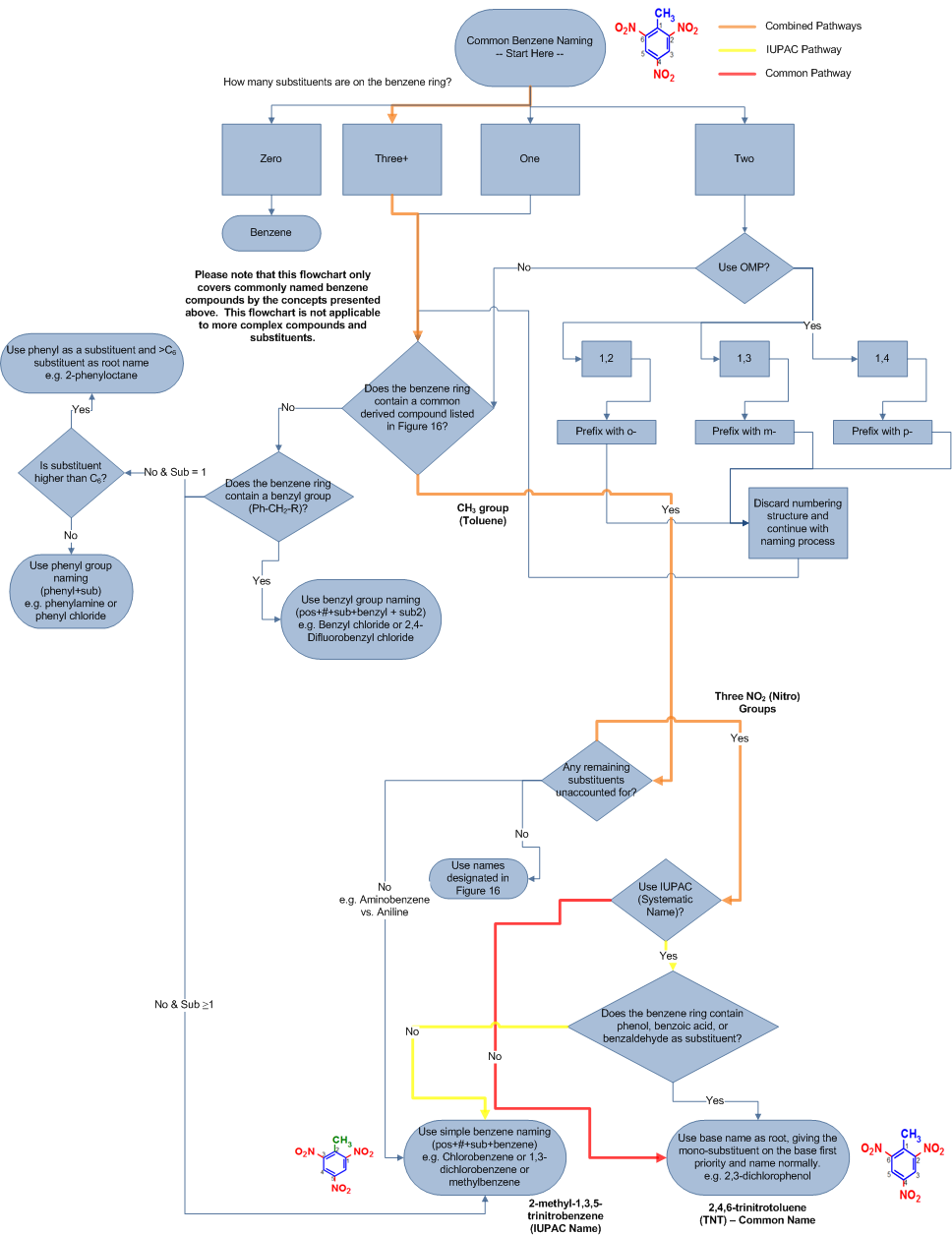Nomenclature of Arenes
- Page ID
- 930
\( \newcommand{\vecs}[1]{\overset { \scriptstyle \rightharpoonup} {\mathbf{#1}} } \)
\( \newcommand{\vecd}[1]{\overset{-\!-\!\rightharpoonup}{\vphantom{a}\smash {#1}}} \)
\( \newcommand{\dsum}{\displaystyle\sum\limits} \)
\( \newcommand{\dint}{\displaystyle\int\limits} \)
\( \newcommand{\dlim}{\displaystyle\lim\limits} \)
\( \newcommand{\id}{\mathrm{id}}\) \( \newcommand{\Span}{\mathrm{span}}\)
( \newcommand{\kernel}{\mathrm{null}\,}\) \( \newcommand{\range}{\mathrm{range}\,}\)
\( \newcommand{\RealPart}{\mathrm{Re}}\) \( \newcommand{\ImaginaryPart}{\mathrm{Im}}\)
\( \newcommand{\Argument}{\mathrm{Arg}}\) \( \newcommand{\norm}[1]{\| #1 \|}\)
\( \newcommand{\inner}[2]{\langle #1, #2 \rangle}\)
\( \newcommand{\Span}{\mathrm{span}}\)
\( \newcommand{\id}{\mathrm{id}}\)
\( \newcommand{\Span}{\mathrm{span}}\)
\( \newcommand{\kernel}{\mathrm{null}\,}\)
\( \newcommand{\range}{\mathrm{range}\,}\)
\( \newcommand{\RealPart}{\mathrm{Re}}\)
\( \newcommand{\ImaginaryPart}{\mathrm{Im}}\)
\( \newcommand{\Argument}{\mathrm{Arg}}\)
\( \newcommand{\norm}[1]{\| #1 \|}\)
\( \newcommand{\inner}[2]{\langle #1, #2 \rangle}\)
\( \newcommand{\Span}{\mathrm{span}}\) \( \newcommand{\AA}{\unicode[.8,0]{x212B}}\)
\( \newcommand{\vectorA}[1]{\vec{#1}} % arrow\)
\( \newcommand{\vectorAt}[1]{\vec{\text{#1}}} % arrow\)
\( \newcommand{\vectorB}[1]{\overset { \scriptstyle \rightharpoonup} {\mathbf{#1}} } \)
\( \newcommand{\vectorC}[1]{\textbf{#1}} \)
\( \newcommand{\vectorD}[1]{\overrightarrow{#1}} \)
\( \newcommand{\vectorDt}[1]{\overrightarrow{\text{#1}}} \)
\( \newcommand{\vectE}[1]{\overset{-\!-\!\rightharpoonup}{\vphantom{a}\smash{\mathbf {#1}}}} \)
\( \newcommand{\vecs}[1]{\overset { \scriptstyle \rightharpoonup} {\mathbf{#1}} } \)
\( \newcommand{\vecd}[1]{\overset{-\!-\!\rightharpoonup}{\vphantom{a}\smash {#1}}} \)
\(\newcommand{\avec}{\mathbf a}\) \(\newcommand{\bvec}{\mathbf b}\) \(\newcommand{\cvec}{\mathbf c}\) \(\newcommand{\dvec}{\mathbf d}\) \(\newcommand{\dtil}{\widetilde{\mathbf d}}\) \(\newcommand{\evec}{\mathbf e}\) \(\newcommand{\fvec}{\mathbf f}\) \(\newcommand{\nvec}{\mathbf n}\) \(\newcommand{\pvec}{\mathbf p}\) \(\newcommand{\qvec}{\mathbf q}\) \(\newcommand{\svec}{\mathbf s}\) \(\newcommand{\tvec}{\mathbf t}\) \(\newcommand{\uvec}{\mathbf u}\) \(\newcommand{\vvec}{\mathbf v}\) \(\newcommand{\wvec}{\mathbf w}\) \(\newcommand{\xvec}{\mathbf x}\) \(\newcommand{\yvec}{\mathbf y}\) \(\newcommand{\zvec}{\mathbf z}\) \(\newcommand{\rvec}{\mathbf r}\) \(\newcommand{\mvec}{\mathbf m}\) \(\newcommand{\zerovec}{\mathbf 0}\) \(\newcommand{\onevec}{\mathbf 1}\) \(\newcommand{\real}{\mathbb R}\) \(\newcommand{\twovec}[2]{\left[\begin{array}{r}#1 \\ #2 \end{array}\right]}\) \(\newcommand{\ctwovec}[2]{\left[\begin{array}{c}#1 \\ #2 \end{array}\right]}\) \(\newcommand{\threevec}[3]{\left[\begin{array}{r}#1 \\ #2 \\ #3 \end{array}\right]}\) \(\newcommand{\cthreevec}[3]{\left[\begin{array}{c}#1 \\ #2 \\ #3 \end{array}\right]}\) \(\newcommand{\fourvec}[4]{\left[\begin{array}{r}#1 \\ #2 \\ #3 \\ #4 \end{array}\right]}\) \(\newcommand{\cfourvec}[4]{\left[\begin{array}{c}#1 \\ #2 \\ #3 \\ #4 \end{array}\right]}\) \(\newcommand{\fivevec}[5]{\left[\begin{array}{r}#1 \\ #2 \\ #3 \\ #4 \\ #5 \\ \end{array}\right]}\) \(\newcommand{\cfivevec}[5]{\left[\begin{array}{c}#1 \\ #2 \\ #3 \\ #4 \\ #5 \\ \end{array}\right]}\) \(\newcommand{\mattwo}[4]{\left[\begin{array}{rr}#1 \amp #2 \\ #3 \amp #4 \\ \end{array}\right]}\) \(\newcommand{\laspan}[1]{\text{Span}\{#1\}}\) \(\newcommand{\bcal}{\cal B}\) \(\newcommand{\ccal}{\cal C}\) \(\newcommand{\scal}{\cal S}\) \(\newcommand{\wcal}{\cal W}\) \(\newcommand{\ecal}{\cal E}\) \(\newcommand{\coords}[2]{\left\{#1\right\}_{#2}}\) \(\newcommand{\gray}[1]{\color{gray}{#1}}\) \(\newcommand{\lgray}[1]{\color{lightgray}{#1}}\) \(\newcommand{\rank}{\operatorname{rank}}\) \(\newcommand{\row}{\text{Row}}\) \(\newcommand{\col}{\text{Col}}\) \(\renewcommand{\row}{\text{Row}}\) \(\newcommand{\nul}{\text{Nul}}\) \(\newcommand{\var}{\text{Var}}\) \(\newcommand{\corr}{\text{corr}}\) \(\newcommand{\len}[1]{\left|#1\right|}\) \(\newcommand{\bbar}{\overline{\bvec}}\) \(\newcommand{\bhat}{\widehat{\bvec}}\) \(\newcommand{\bperp}{\bvec^\perp}\) \(\newcommand{\xhat}{\widehat{\xvec}}\) \(\newcommand{\vhat}{\widehat{\vvec}}\) \(\newcommand{\uhat}{\widehat{\uvec}}\) \(\newcommand{\what}{\widehat{\wvec}}\) \(\newcommand{\Sighat}{\widehat{\Sigma}}\) \(\newcommand{\lt}{<}\) \(\newcommand{\gt}{>}\) \(\newcommand{\amp}{&}\) \(\definecolor{fillinmathshade}{gray}{0.9}\)Benzene, C6H6, is an organic aromatic compound with many interesting properties. Unlike aliphatic (straight chain carbons) or other cyclic organic compounds, the structure of benzene (3 conjugated π bonds) allows benzene and its derived products to be useful in fields such as health, laboratory, and other applications such as rubber synthesis.
Introduction
Benzene derived products are well known to be pleasantly fragrant. For this reason, organic compounds containing benzene rings were classified as being "aromatic" (sweet smelling) amongst scientists in the early 19th century when a relation was established between benzene derived compounds and sweet/spicy fragrances. There is a misconception amongst the scientific community, however, that all aromatics are sweet smelling and that all sweet smelling compounds would have a benzene ring in its structure. This is false, since non-aromatic compounds, such as camphor, extracted from the camphor laurel tree, release a strong, minty aroma, yet it lacks the benzene ring in its structure (Figure 1). On the other hand, benzene itself gives off a rather strong and unpleasant smell that would otherwise invalidate the definition of an aromatic (sweet-smelling) compound. Despite this inconsistency, however, the term aromatic continues to be used today in order to designate molecules with benzene-like rings in their structures. For a modern, chemical definition of aromaticity, refer to sections Aromaticity and Hückel's Rule.
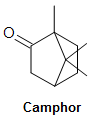
Figure 1. Top-view of camphor, along with its monoterpene unit. Notice how camphor lacks the benzene ring to be "aromatic".
Many aromatic compounds are however, sweet/pleasant smelling. Eugenol, for example, is extracted from essential oils of cloves and it releases a spicy, clove-like aroma used in perfumes. In addition, it is also used in dentistry as an analgesic.
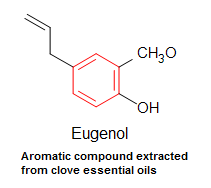
Figure 2. Eugenol, an aromatic compound extracted from clove essential oils. Used in perfumes and as an analgesic. The benzene ring is labeled in red in the eugenol molecule.
Is it cyclohexane or is it benzene?
Due to the similarity between benzene and cyclohexane, the two is often confused with each other in beginning organic chemistry students.

Figure 3. Structure comparison between cyclohexane and benzene
If you were to count the number of carbons and hydrogens in cyclohexane, you will notice that its molecular formula is C6H12. Since the carbons in the cyclohexane ring is fully saturated with hydrogens (carbon is bound to 2 hydrogens and 2 adjacent carbons), no double bonds are formed in the cyclic ring. In contrast, benzene is only saturated with one hydrogen per carbon, leading to its molecular formula of C6H6. In order to stabilize this structure, 3 conjugated π (double) bonds are formed in the benzene ring in order for carbon to have four adjacent bonds.
In other words, cyclohexane is not the same as benzene! These two compounds have different molecular formulas and their chemical and physical properties are not the same. The hydrogenation technique can be used by chemists to convert from benzene to cyclohexane by saturating the benzene ring with missing hydrogens.
A special catalyst is required to hydrogenate benzene rings due to its unusual stability and configuration. Normal catalytic hydrogenation techniques will not hydrogenate benzene and yield any meaningful products.
What about Resonance?
Benzene can be drawn a number of different ways. This is because benzene's conjugated pi electrons freely resonate within the cyclic ring, thus resulting in its two resonance forms.
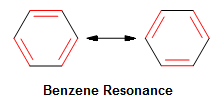
Figure 4. The Figure to the left shows the two resonance forms of benzene. The delocalized electrons are moved from one carbon to the next, thus providing stabilization energy. Ring structures stabilized by the movement of delocalized electrons are sometimes referred to as arenes.


.png?revision=1&size=bestfit&width=70&height=70)

As the electrons in the benzene ring can resonate within the ring at a fairly high rate, a simplified notation is often used to designate the two different resonance forms. This notation is shown above, with the initial three pi bonds (#1, #2) replaced with an inner ring circle (#3). Alternatively, the circle within the benzene ring can also be dashed to show the same resonance forms (#4).
The Formation of the Phenyl Group and its Derivatives
The phenyl group can be formed by taking benzene, and removing a hydrogen from it. The resulting molecular formula for the fragment is C6H5. NOTE: Although the molecular formula of the phenyl group is C6H5, the phenyl group would always have something attached to where the hydrogen was removed. Thus, the formula is often written as Ph-R, where Ph refers to the Phenyl group, and R refers to the R group attached to where the hydrogen was removed.
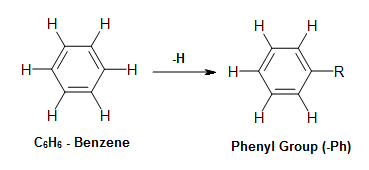
Figure 5. Figure demonstrating the removal of hydrogen to form the phenyl group.
Different R groups on the phenyl group allows different benzene derivatives to be formed. Phenol, Ph-OH, or C6H5OH, for example, is formed when an alcohol (-OH) group displaces a hydrogen atom on the benzene ring. Benzene, for this very same reason, can be formed from the phenyl group by reattaching the hydrogen back its place of removal. Thus benzene, similar to phenol, can be abbreviated Ph-H, or C6H6.

Figure 7: Epigallocatechin gallate (EGCG), an antioxidant found in green teas and its extracts, is famous for its potential health benefits. The molecule is a type of catechin, which is composed of multiple phenol (labeled in red) units (polyphenols - see polycyclic aromatics). Since catechins are usually found in plant extracts, they are often referred as plant polyphenolic antioxidants.
As you can see above, these are only some of the many possibilities of the benzene derived products that have special uses in human health and other industrial fields.
Nomenclature of Benzene Derived Compounds
Unlike aliphatic organics, nomenclature of benzene-derived compounds can be confusing because a single aromatic compound can have multiple possible names (such as common and systematic names) be associated with its structure. In these sections, we will analyze some of the ways these compounds can be named.
Simple Benzene Naming
Some common substituents, like NO2, Br, and Cl, can be named this way when it is attached to a phenyl group. Long chain carbons attached can also be named this way. The general format for this kind of naming is:
(positions of substituents (if >1)- + # (di, tri, ...) + substituent)n + benzene.
For example, chlorine (Cl) attached to a phenyl group would be named chlorobenzene (chloro + benzene). Since there is only one substituent on the benzene ring, we do not have to indicate its position on the benzene ring (as it can freely rotate around and you would end up getting the same compound.)
.png?revision=1&size=bestfit&width=320&height=160)
.png?revision=1&size=bestfit&width=320&height=160)
Figure 8. Example of simple benzene naming with chlorine and NO2 as substituents.
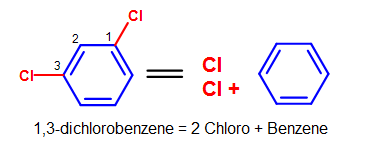

Figure 9. More complicated simple benzene naming examples - Note that standard nomenclature priority rules are applied here, causing the numbering of carbons to switch. See Nomenclature of Organic Compounds for a review on naming and priority rules.
Ortho-, Meta-, Para- (OMP) Nomenclature for Disubstituted Benzenes
Instead of using numbers to indicate substituents on a benzene ring, ortho- (o-), meta- (m-), or para (p-) can be used in place of positional markers when there are two substituents on the benzene ring (disubstituted benzenes). They are defined as the following:
- ortho- (o-): 1,2- (next to each other in a benzene ring)
- meta- (m): 1,3- (separated by one carbon in a benzene ring)
- para- (p): 1,4- (across from each other in a benzene ring)
Using the same example above in Figure 9a (1,3-dichlorobenzene), we can use the ortho-, meta-, para- nomenclature to transform the chemical name into m-dichlorobenzene, as shown in the Figure below.

Figure 10. Transformation of 1,3-dichlorobenzene into m-dichlorobenzene.
Here are some other examples of ortho-, meta-, para- nomenclature used in context:
However, the substituents used in ortho-, meta-, para- nomenclature do not have to be the same. For example, we can use chlorine and a nitro group as substituents in the benzene ring.
In conclusion, these can be pieced together into a summary diagram, as shown below:
.png?revision=1&size=bestfit&width=511&height=192)
Base Name Nomenclature
In addition to simple benzene naming and OMP nomenclature, benzene derived compounds are also sometimes used as bases. The concept of a base is similar to the nomenclature of aliphatic and cyclic compounds, where the parent for the organic compound is used as a base (a name for its chemical name. For example, the following compounds have the base names hexane and cyclohexane, respectively. See Nomenclature of Organic Compounds for a review on naming organic compounds.
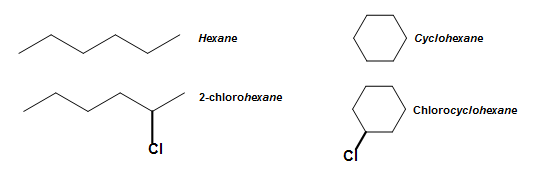
Benzene, similar to these compounds shown above, also has base names from its derived compounds. Phenol (C6H5OH), as introduced previously in this article, for example, serves as a base when other substituents are attached to it. This is best illustrated in the diagram below.
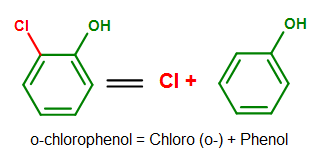
Figure 14. An example showing phenol as a base in its chemical name. Note how benzene no longer serves as a base when an OH group is added to the benzene ring.
Alternatively, we can use the numbering system to indicate this compound. When the numbering system is used, the carbon where the substituent is attached on the base will be given the first priority and named as carbon #1 (C1). The normal priority rules then apply in the nomenclature process (give the rest of the substituents the lowest numbering as you could).

Figure 15. The naming process for 2-chlorophenol (o-chlorophenol). Note that 2-chlorophenol = o-chlorophenol.
Below is a list of commonly seen benzene-derived compounds. Some of these mono-substituted compounds (labeled in red and green), such as phenol or toluene, can be used in place of benzene for the chemical's base name.

Figure 16. Common benzene derived compounds with various substituents.

Common vs. Systematic (IUPAC) Nomenclature
According to the indexing preferences of the Chemical Abstracts, phenol, benzaldehyde, and benzoic acid (labeled in red in Figure 16) are some of the common names that are retained in the IUPAC (systematic) nomenclature. Other names such as toluene, styrene, naphthalene, or phenanthrene can also be seen in the IUPAC system in the same way. While the use of other common names are usually acceptable in IUPAC, their use are discouraged in the nomenclature of compounds.
Nomenclature for compounds which has such discouraged names will be named by the simple benzene naming system. An example of this would include toluene derivatives like TNT. (Note that toluene by itself is retained by the IUPAC nomenclature, but its derivatives, which contains additional substituents on the benzene ring, might be excluded from the convention). For this reason, the common chemical name 2,4,6-trinitrotoluene, or TNT, as shown in Figure 17, would not be advisable under the IUPAC (systematic) nomenclature.
In order to correctly name TNT under the IUPAC system, the simple benzene naming system should be used:

Figure 18. Systematic (IUPAC) name of 2,4,6-trinitrotoluene (common name), or TNT. Note that the methyl group is individually named due to the exclusion of toluene from the IUPAC nomenclature.

Figure 19. The common name 2,4-dibromophenol, is shared by the IUPAC systematic nomenclature. Only substituents phenol, benzoic acid, and benzaldehyde share this commonality.
Since the IUPAC nomenclature primarily rely on the simple benzene naming system for the nomenclature of different benzene derived compounds, the OMP (ortho-, meta-, para-) system is not accepted in the IUPAC nomenclature. For this reason, the OMP system will yield common names that can be converted to systematic names by using the same method as above. For example, o-Xylene from the OMP system can be named 1,2-dimethylbenzene by using simple benzene naming (IUPAC standard).
The Phenyl and Benzyl Groups
The Phenyl Group
As mentioned previously, the phenyl group (Ph-R, C6H5-R) can be formed by removing a hydrogen from benzene and attaching a substituent to where the hydrogen was removed. To this phenomenon, we can name compounds formed this way by applying this rule: (phenyl + substituent). For example, a chlorine attached in this manner would be named phenyl chloride, and a bromine attached in this manner would be named phenyl bromide. (See below diagram)

Figure 20. Naming of Phenyl Chloride and Phenyl Bromide
While compounds like these are usually named by simple benzene type naming (chlorobenzene and bromobenzene), the phenyl group naming is usually applied to benzene rings where a substituent with six or more carbons is attached, such as in the diagram below.

Figure 21. Diagram of 2-phenyloctane.
Although the diagram above might be a little daunting to understand at first, it is not as difficult as it seems after careful analysis of the structure is made. By looking for the longest chain in the compound, it should be clear that the longest chain is eight (8) carbons long (octane, as shown in green) and that a benzene ring is attached to the second position of this longest chain (labeled in red). As this rule suggests that the benzene ring will act as a function group (a substituent) whenever a substituent of more than six (6) carbons is attached to it, the name "benzene" is changed to phenyl and is used the same way as any other substituents, such as methyl, ethyl, or bromo. Putting it all together, the name can be derived as: 2-phenyloctane (phenyl is attached at the second position of the longest carbon chain, octane).
The Benzyl Group
The benzyl group (abbv. Bn), similar to the phenyl group, is formed by manipulating the benzene ring. In the case of the benzyl group, it is formed by taking the phenyl group and adding a CH2 group to where the hydrogen was removed. Its molecular fragment can be written as C6H5CH2-R, PhCH2-R, or Bn-R. Nomenclature of benzyl group based compounds are very similar to the phenyl group compounds. For example, a chlorine attached to a benzyl group would simply be called benzyl chloride, whereas an OH group attached to a benzyl group would simply be called benzyl alcohol.
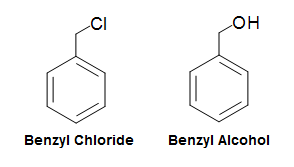
Figure 22. Benzyl Group Nomenclature
Additionally, other substituents can attach on the benzene ring in the presence of the benzyl group. An example of this can be seen in the Figure below:

Figure 23. Nomenclature of 2,4-difluorobenzyl chloride. Similar to the base name nomenclatures system, the carbon in which th base substitutent is attached on the benzene ring is given the first priority and the rest of the substituents are given the lowest number order possible.
Similar to the base name nomenclature system, the carbon in which the base substituent is attached on the benzene ring is given the first priority and the rest of the substituents are given the lowest number order possible. Under this consideration, the above compound can be named: 2,4-difluorobenzyl chloride.
Commonly Named Benzene Compounds Nomenclature Summary Flowchart
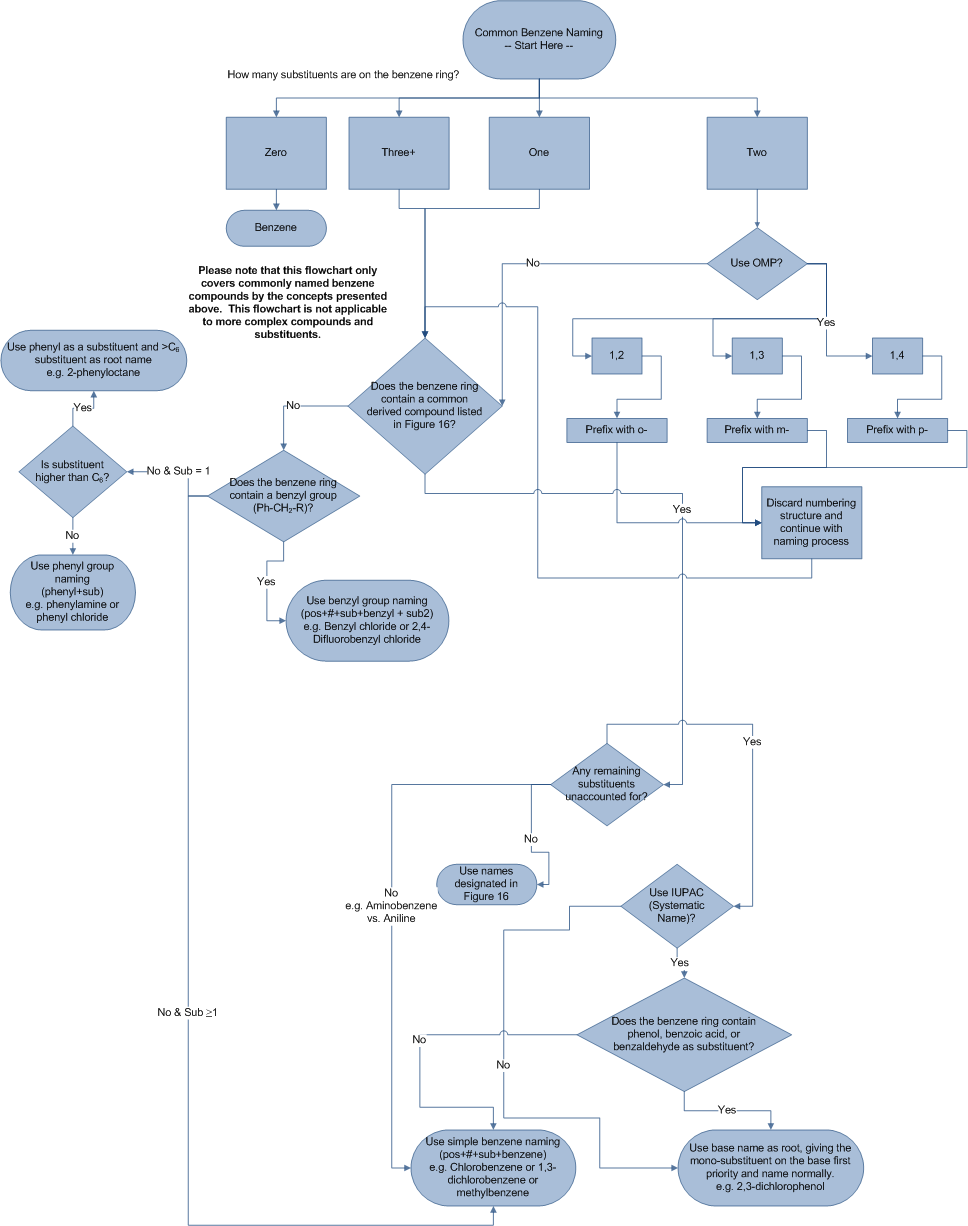
Summary Flowchart (Figure 24). Summary of nomenclature rules used in commonly benzene derived compounds.
As benzene derived compounds can be extremely complex, only compounds covered in this article and other commonly named compounds can be named using this flowchart.
References
- Nicolaou, K. C., & Montagnon, T. (2008). Molecules That Changed the World. KGaA, Weinheim: Wiley-VCH. p. 54
- Pitman, V. (2004). Aromatherapy. Great Britain, UK: Nelson Thornes. p.135-136
- Burton, G. (2000). Chemical Ideas. Bicester, Oxon: Heinemann. p.290-292
- Vollhardt, K. P.C. & Shore, N. (2007). Organic Chemistry (5th Ed.). New York: W. H. Freeman. p. 667-669
- Schnaubelt, K. (1999). Medical Aromatherapy. Berkeley, CA: Frog Books. p. 211-213
- Patrick, G. L. (2004). Organic Chemistry. New York, NY: Taylor & Francis. p. 135-136
- Talbott, S. M. (2002). A Guide to Understanding Dietary Supplements. Binghamton, NY: Haworth Press. p. 616-619
- Lifton, R. J. (2000). The Nazi doctors. New York, NY: Basic Books. p. 255-261
- Myers, R. L., & Myers, R. L. (2007). The 100 most important chemical compounds. Westport, CT: Greenwood Publishing Group. p. 281-282
Practice Problems
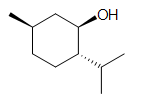
Q1) (True/False) The compound above contains a benzene ring and thus is aromatic.
Q2) Benzene unusual stability is caused by how many conjugated pi bonds in its cyclic ring? ____
Q3) Menthol, a topical analgesic used in many ointments for the relief of pain, releases a peppermint aroma upon exposure to the air. Based on this conclusion, can you imply that a benzene ring is present in its chemical structure? Why or why not?
Q4) 
Q5) At normal conditions, benzene has ___ resonance structures.
Q6) Which of the following name(s) is/are correct for the following compound?

a) nitrohydride benzene
b) phenylamine
c) phenylamide
d) aniline
e) nitrogenhydrogen benzene
f) All of the above is correct
Q7) Convert 1,4-dimethylbenzene into its common name.
Q8) TNT's common name is: ______________________________
Q9) Name the following compound using OMP nomenclature:
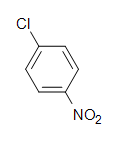
Q10) Draw the structure of 2,4-dinitrotoluene.
Q11) Name the following compound:
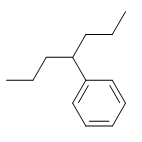
Q12) Which of the following is the correct name for the following compound?

a) 3,4-difluorobenzyl bromide
b) 1,2-difluorobenzyl bromide
c) 4,5-difluorobenzyl bromide
d) 1,2-difluoroethyl bromide
e) 5,6-difluoroethyl bromide
f) 4,5-difluoroethyl bromide
Q13) (True/False) Benzyl chloride can be abbreviated Bz-Cl.
Q14) Benzoic Acid has what R group attached to its phenyl functional group?
Q15) (True/False) A single aromatic compound can have multiple names indicating its structure.
Q16) List the corresponding positions for the OMP system (o-, m-, p-).
Q17) A scientist has conducted an experiment on an unknown compound. He was able to determine that the unknown compound contains a cyclic ring in its structure as well as an alcohol (-OH) group attached to the ring. What is the unknown compound?
a) Cyclohexanol
b) Cyclicheptanol
c) Phenol
d) Methanol
e) Bleach
f) Cannot determine from the above information
Q18) Which of the following statements is false for the compound, phenol?
a) Phenol is a benzene derived compound.
b) Phenol can be made by attaching an -OH group to a phenyl group.
c) Phenol is highly toxic to the body even in small doses.
d) Phenol can be used as a catalyst in the hydrogenation of benzene into cyclohexane.
e) Phenol is used as an antiseptic in minute doses.
f) Phenol is amongst one of the three common names retained in the IUPAC nomenclature.
Answer Key to Practice Questions
Q1) False, this compound does not contain a benzene ring in its structure.
Q2) 3
Q3) No, a substance that is fragrant does not imply a benzene ring is in its structure. See camphor example (Figure 1)
Q4) No reaction, benzene requires a special catalyst to be hydrogenated due to its unusual stability given by its three conjugated pi bonds.
Q5) 2
Q6) b, d
Q7) p-Xylene
Q8) 2,4,6-trinitrotoluene
Q9) p-chloronitrobenzene
Q10) 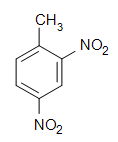
Q11) 4-phenylheptane
Q12) a
Q13) False, the correct abbreviation for the benzyl group is Bn, not Bz. The correct abbreviation for Benzyl chloride is Bn-Cl.
Q14) COOH
Q15) True. TNT, for example, has the common name 2,4,6-trinitrotoluene and its systematic name is 2-methyl-1,3,5-trinitrobenzene.
Q16) Ortho - 1,2 ; Meta - 1,3 ; Para - 1,4
Q17) The correct answer is f). We cannot determine what structure this is since the question does not tell us what kind of cyclic ring the -OH group is attached on. Just as cyclohexane can be cyclic, benzene and cycloheptane can also be cyclic.
Q18) d
Contributors
- David Lam





